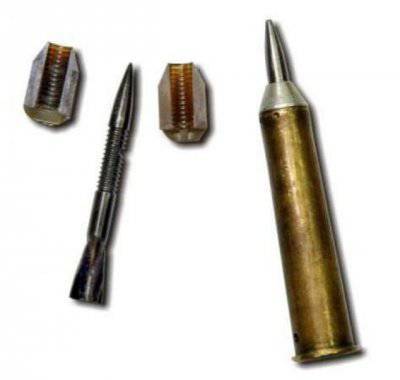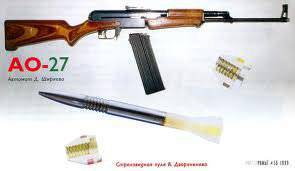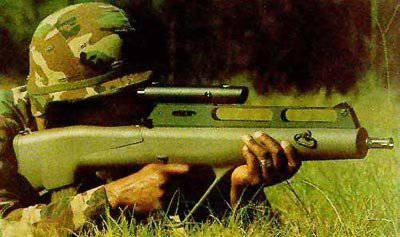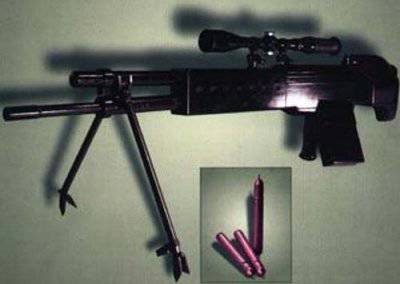Arrow bullets
 Naturally, attempts to make the cartridges more effective were, but for some reason, in the direction in which it was necessary, the designers stubbornly refused to go. All run into the classic design of the cartridge and its bullets. Of course, there are bold solutions, such as an attempt to create a cartridgeless cartridge, but if you think about it, such ammunition was created not to improve its characteristics, and accordingly, the characteristics of the weapon, but to make the design of the weapon itself simpler and more reliable . Much more promising are the work on creating a cartridge with arrow-shaped bullet.
Naturally, attempts to make the cartridges more effective were, but for some reason, in the direction in which it was necessary, the designers stubbornly refused to go. All run into the classic design of the cartridge and its bullets. Of course, there are bold solutions, such as an attempt to create a cartridgeless cartridge, but if you think about it, such ammunition was created not to improve its characteristics, and accordingly, the characteristics of the weapon, but to make the design of the weapon itself simpler and more reliable . Much more promising are the work on creating a cartridge with arrow-shaped bullet.It would seem that the times of bows and crossbows are long gone, and they were completely replaced by firearms, but at the same time they were inherently ideal examples of weapons that could send a missile projectile with a sufficiently high accuracy to the target. Much more interesting is that this weapon did not have a barrel, and the stabilization of the missile projectile was carried out due to its length and tail. Thus, the invention of such a device, I personally think is much more important in stories humanity, rather than a firearm. After all, even to guess that it would be nice to stabilize a bullet, not one hundred years went away, but an example of what needs to be done is always there, as is the solution to this problem, even with a smooth barrel.
But not everyone missed this clear example by. There is evidence that the arrows tried to charge smooth-bore weapons in the 17 century. This gave a definite advantage in firing range over the enemy, but since the manufacture of these arrows was a laborious process, the decision to increase the real caliber of the boom to the caliber of the weapon was not the use of wooden cylinders in half, the boom was placed between the halves of which The idea has not received. But personally, I do not even doubt that if at that time more bright minds broke their brains over this task, then a cartridge in the form to which we are accustomed now could not exist. And even perhaps now the article would be written just about the cartridges with the classic designs of bullets, and the cheapness of production of these ammunition would be noted.
 They were returned to the arrow-bullets only in the second half of the twentieth century, since already at that time it became clear that the capabilities of the usual design ammunition are very limited. The championship, unfortunately, in this matter does not belong to us, but we were the first to succeed by creating a fully viable ammunition and even a weapon for it. We are talking about the machine AO-27, which never went into the series. As noted by the designers themselves, the best option was to start creating a cartridge for large-caliber weapons, since the three-millimeter arrow did not show those over the results that were required by the management. But to rush from side to side was completely out of place, because the work on the cartridge and on the weapon was brought to its logical conclusion, that is, the creation of a fully working sample, which took pride of place among other bold experimental ideas. The advancement of the weapon prevented that the 5,45x39 cartridge was on the way, and since the main focus on the demonstration of the weapon and ammunition with the arrow-shaped bullet was made for a small return, it was easy to guess which option was preferred. After all, despite the lower flatness, penetration efficiency and so on, it was cheaper, and the recoil momentum was almost the same, although everything here depends on the type of weapon in which the cartridge is used. In general, it was for that to cling to failure, but there was no need for anything more. In the end, the refusal was given to other more sophisticated models than those that were in service, and with more strange formulations and far-fetched reasons. But let's not focus on one sample, especially since the machine itself and the cartridge are more than worthy of a separate full review.
They were returned to the arrow-bullets only in the second half of the twentieth century, since already at that time it became clear that the capabilities of the usual design ammunition are very limited. The championship, unfortunately, in this matter does not belong to us, but we were the first to succeed by creating a fully viable ammunition and even a weapon for it. We are talking about the machine AO-27, which never went into the series. As noted by the designers themselves, the best option was to start creating a cartridge for large-caliber weapons, since the three-millimeter arrow did not show those over the results that were required by the management. But to rush from side to side was completely out of place, because the work on the cartridge and on the weapon was brought to its logical conclusion, that is, the creation of a fully working sample, which took pride of place among other bold experimental ideas. The advancement of the weapon prevented that the 5,45x39 cartridge was on the way, and since the main focus on the demonstration of the weapon and ammunition with the arrow-shaped bullet was made for a small return, it was easy to guess which option was preferred. After all, despite the lower flatness, penetration efficiency and so on, it was cheaper, and the recoil momentum was almost the same, although everything here depends on the type of weapon in which the cartridge is used. In general, it was for that to cling to failure, but there was no need for anything more. In the end, the refusal was given to other more sophisticated models than those that were in service, and with more strange formulations and far-fetched reasons. But let's not focus on one sample, especially since the machine itself and the cartridge are more than worthy of a separate full review.Proceeding from all the above, it is clear that the arrow-bullets have the greatest advantage over the bullets of classical designs in large-caliber weapons, and the designers themselves agree with this, and it is difficult to argue with them. With the assumption that anti-tank guns in 80-ies received new life in the form of large-caliber sniper rifles, and large-caliber machine guns did not disappear anywhere, firmly taking their place in the armament of armies of all countries, bullet cartridges can significantly improve such weapons. And there are living examples of this, but about them below. For now, let's try to understand the advantages of arrow-shaped bullets, which for some reason are always forgotten. A large direct shot range, better penetrability of personal armor and equipment armor is, of course, all well and good, but apart from this, such bullets do not actually touch the weapon’s barrel, contact with the barrel has only a glass in which a bullet is located, or a cylinder in which it clamped. Based on the fact that the chemical industry is developed to the level when the polymers are strong enough to withstand the pressure of powder gases and can slide on the metal without experiencing resistance, we can say that the life of the barrels of weapons for bullets with a swept bullet will be many times more than with bullets classic designs. And if we take into account the fact that a rifled barrel is not needed for such a weapon, then we get the same machine gun with a durable and cheap barrel. In other words, when using such ammunition, not only higher firing efficiency can be achieved, but the cost of weapon maintenance will be significantly reduced, and the cost of the weapon itself will be reduced due to a smooth barrel. I think that even under the condition of similar results on the effectiveness of fire, such advantages are already sufficient grounds for switching to a cartridge with a swept bullet.
 The effectiveness of munitions with a arrow-shaped bullet in large-caliber weapons was proven by the Austrians, and proved so well that it becomes unclear why their sample of a large-caliber sniper rifle was not accepted for service, and although the weapon was minimally spread, it could rather be attributed to experimental samples. Or rather, the resulting weapon can not even be considered a rifle, because the rifle implies the presence of a rifled barrel, which is not in the Steyr AMR KSV, so it would be more appropriate to call this weapon a sniper large-caliber rifle. However, in such situations, using standard definitions is a thankless job, since here you can look at the question from different sides and in each version there will be a grain of truth.
The effectiveness of munitions with a arrow-shaped bullet in large-caliber weapons was proven by the Austrians, and proved so well that it becomes unclear why their sample of a large-caliber sniper rifle was not accepted for service, and although the weapon was minimally spread, it could rather be attributed to experimental samples. Or rather, the resulting weapon can not even be considered a rifle, because the rifle implies the presence of a rifled barrel, which is not in the Steyr AMR KSV, so it would be more appropriate to call this weapon a sniper large-caliber rifle. However, in such situations, using standard definitions is a thankless job, since here you can look at the question from different sides and in each version there will be a grain of truth.Since I had previously written article about this sample, we confine ourselves only to the most important characteristic of a weapon, namely, an example of penetration of armor at a fairly decent distance. No matter how hard it is to believe, but at a distance of 1000 meters, the arrow surely pierces 40 millimeters of homogeneous armor, while reducing the boom from the aiming line at this distance is 80 centimeters. And now we will try to find cartridges with a classic bullet design, which can boast the same results, although you can not waste time, there are no such cartridges.
 Naturally, a shot of such weapons will be at the moment more expensive than when using cartridges, the production of which is already established. But if you adjust the production of arrow-shaped ammunition, the cost difference will sharply decrease. Add to this the savings in the production of trunks and their increased resource and go "to zero", and then still get the benefit, it remains only to come up with a rational production technology, which, I think, the problem is quite solvable. The weapon did not go “to the masses” precisely because the rifle itself was not the cheapest (the cost of the weapon was mainly increased due to the fact that the weapon has a rather complicated recoil damping system) uses a non-standard cartridge, the production of which of course is not established. In addition, there were other moments, but they are inherent in all arrow-shaped bullet cartridges, but consider the negative at the end of the article.
Naturally, a shot of such weapons will be at the moment more expensive than when using cartridges, the production of which is already established. But if you adjust the production of arrow-shaped ammunition, the cost difference will sharply decrease. Add to this the savings in the production of trunks and their increased resource and go "to zero", and then still get the benefit, it remains only to come up with a rational production technology, which, I think, the problem is quite solvable. The weapon did not go “to the masses” precisely because the rifle itself was not the cheapest (the cost of the weapon was mainly increased due to the fact that the weapon has a rather complicated recoil damping system) uses a non-standard cartridge, the production of which of course is not established. In addition, there were other moments, but they are inherent in all arrow-shaped bullet cartridges, but consider the negative at the end of the article.If we talk about machine guns, chambered with an arrow-shaped bullet, then “behind the hill” several samples were also created, the most interesting of which, in my opinion, is the machine created, again, by Steyr. Well, I can’t do anything, I like the products of this company, and besides, they are not afraid to take on dubious projects that are clearly doomed to failure and not paying attention to costs make a huge contribution to the development of firearms. The machine was created as part of the ACR program and, despite very good test results, also remained experimental. Again, I highly recommend to get acquainted with this weapon. in a separate article about him.
 As for the domestic development of large-caliber sniper rifles, then you cannot pass by such weapons as the Ascoria KSV, which was created by Ukrainian designers. Many even question the existence of this weapon, but there are even eyewitnesses to its combat use, so that the weapon really exists and is not the fruit of someone's imagination. A serial weapon is not produced, in fact it is not officially issued at all, but here and there, this rifle says a couple of its “words”, which are remembered and defined unmistakably. The self-loading rifle, the real caliber of the 13,2 millimeter weapon, unfortunately, failed to find the exact and undoubted characteristics of the cartridge itself, which is a good incentive to dig around better and prepare a separate detailed article about the weapon. By armor-piercing weapons turned out not much worse than the Austrian version. At a distance of 600 meters, an arrow confidently pierces 50 millimeters of steel, which is unknown. The speed of the bullet at the muzzle is 1500 meters per second, which greatly facilitates firing at moving targets. In general, I will not disclose all the information about the rifle, since then it will simply be uninteresting to read an article about it.
As for the domestic development of large-caliber sniper rifles, then you cannot pass by such weapons as the Ascoria KSV, which was created by Ukrainian designers. Many even question the existence of this weapon, but there are even eyewitnesses to its combat use, so that the weapon really exists and is not the fruit of someone's imagination. A serial weapon is not produced, in fact it is not officially issued at all, but here and there, this rifle says a couple of its “words”, which are remembered and defined unmistakably. The self-loading rifle, the real caliber of the 13,2 millimeter weapon, unfortunately, failed to find the exact and undoubted characteristics of the cartridge itself, which is a good incentive to dig around better and prepare a separate detailed article about the weapon. By armor-piercing weapons turned out not much worse than the Austrian version. At a distance of 600 meters, an arrow confidently pierces 50 millimeters of steel, which is unknown. The speed of the bullet at the muzzle is 1500 meters per second, which greatly facilitates firing at moving targets. In general, I will not disclose all the information about the rifle, since then it will simply be uninteresting to read an article about it.Well, "for sweet" we will analyze the negative qualities of ammunition. It goes without saying that arrow-shaped bullet cartridges will be a little more expensive, it goes without saying that with a small caliber of the arrow itself, the stopping effect of the bullet will be low and not always the same. By the way, domestic designers coped with the problem of a lower stopping effect, making a small cut on the body of the arrow. As a result, the armor-piercing properties almost disappeared, but when it hit the body, the arrow either broke open or bent, turning everything into stuffing on its way. But with what really can not cope, it is not with the highest accuracy at short distances, in which the arrow-shaped bullets are inferior to the bullets of classical designs. However, this is compensated by higher accuracy at medium and long distances, so that, as noted above, arrow-shaped bullet cartridges are ideal ammunition for large-caliber sniper rifles and large-caliber machine guns.
Information